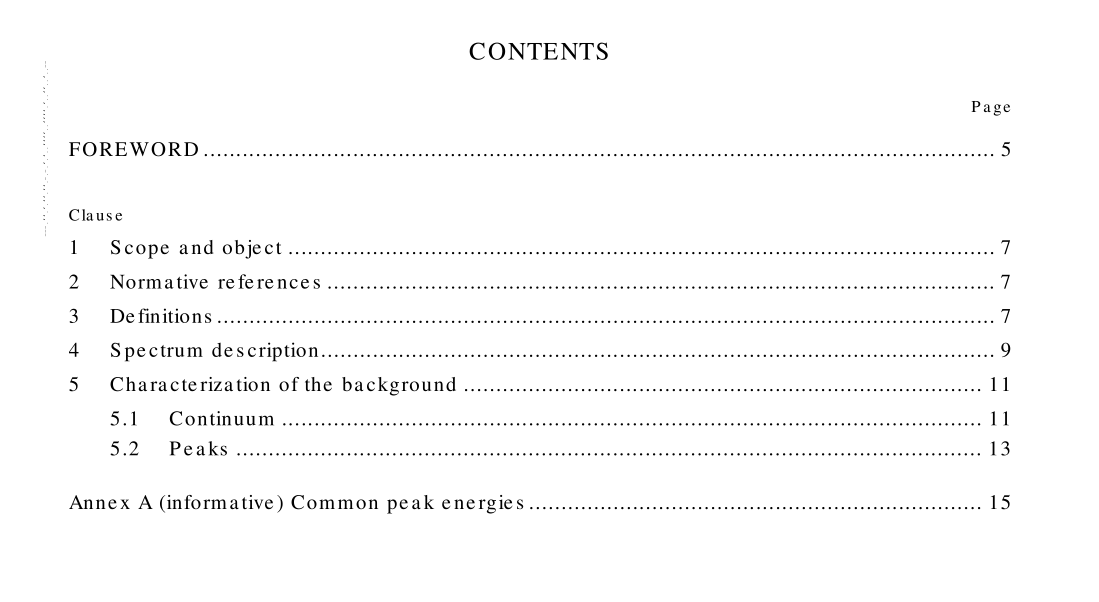IEC 61976 pdf download

IEC 61976 pdf download.Nuclear instrumentation – Spectrometry – Characterization of the spectrum background in HPGe gamma-ray spectrometry
1 Scope and object
This International Standard applies to gamma-ray spectra collected with hyperpure germanium detectors (HPGe) for use in gamma-ray spectrometry, especially for low-background detectors and measurements. This standard defines terms used to describe the background and the background spectrum itself. This standard does not present methods that describe how to reduce the background. The object of this standard is to provide a uniform method for describing and characterizing the background in a spectrum from an HPGe detector. Definitions and methods are applied to define values for an HPGe detector that is considered to be used for low-background measurements. This approach provides both manufacturers and end users with a way to specify the low-background performance of the detector and allows the comparison of detectors used for these kinds of measurements. The background and peak values determined by the procedures in this standard will provide the user with information regarding the expected background performance of the detector, in particular to allow for the comparison of several different detectors.
2 Normative references
The following normative documents contain provisions which, through reference in this text, constitute provisions of this International Standard. For dated references, subsequent amendments to, or revisions of, any of these publications do not apply. However, parties to agreements based on this International Standard are encouraged to investigate the possibility of applying the most recent editions of the normative documents indicated below. For undated references, the latest edition of the normative document referred to applies. Members of IEC and ISO maintain registers of currently valid International Standards. IEC 60050(393):1996, International Electrotechnical Vocabulary (IEV) – Chapter 393: Nuclear instrumentation: Physical phenomena and basic concepts IEC 60050(394):1995, International Electrotechnical Vocabulary (IEV) – Chapter 394: Nuclear instrumentation: Instruments
3 Definitions
For the purpose of this International Standard, the following definitions apply: 3.1 spectrum (of an ionizing radiation) distribution of the values of a specific radiation quantity, usually associated with energy [IEV 393-04-29] 3.2 full width at half maximum (FWHM) in a distribution curve comprising a single peak, the distance between the abscissa of two points on the curve whose ordinates are half of the maximum ordinate of the peak [IEV 394-19-45] 3.3 sample material whose radionuclide content is of interest and is to be measured 3.4 external background spectrum from the HPGe detector in a given configuration without a sample to be measured 3.5 sample-induced background all spectral data due to emissions from the sample that are not in the full-energy peak from any source of emissions placed close to the detector NOTE This term is presented for explanation and is not used in this standard. 3.6 total background sum of the external background and sample-induced background NOTE This term is presented for explanation and is not used in this standard. 3.7 background peak any full-energy peak from any source in the external background spectrum 3.8 background continuum any data that does not belong to a full-energy peak in the external background spectrum 3.9 peak baseline those counts in the peak region from both the sample-induced background and external background that are not due to a full energy peak
4 Spectrum description
The collection time of the background spectrum should be long enough to ensure that the statistical uncertainty is approximately 5 % at one standard deviation in the energy region of 100 kiloelectronvolts (keV). This means that in the 100 keV region of the measured spectrum, the number of counts shall be not lower than 400 per channel. This is to reduce the impact of the statistical uncertainty in the data on the background determination. The number of channels in the spectrum should be sufficient to allow for the energy range of interest to be collected with the energy per channel small enough to make the uncertainty in the calculations due to the variation in the channel-to-energy conversion small compared to the values stated.









